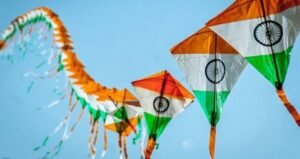Kite Flying Traditions: Independence Day in India is celebrated with great fervor and enthusiasm every year on the 15th of August. Apart from the flag hoisting ceremonies, parades, and cultural events, one of the most vibrant and cherished traditions on this day is kite flying. As Indians unite to commemorate the nation’s freedom struggle, the sky fills up with an array of beautifully designed kites.
Read this also: Choosing the Perfect Diwali Gifts: A Guide to Delight Your Loved Ones
Let’s explore some of the types of kites that are flown during Independence Day in India

1. National Flag Kites
The Indian national flag is a tricolor banner with saffron, white, and green stripes and a blue Ashoka Chakra in the center. Kite enthusiasts craft kites resembling the flag, ensuring the colors and patterns perfectly imitate the national symbol. It is a powerful representation of patriotism and love for the country.
2. India Gate Kites
The India Gate is a significant monument in New Delhi, the capital city of India. Kites designed as mini replicas of the India Gate are popular during Independence Day. These kites depict the architectural magnificence of the monument and symbolize the spirit and resilience of the nation.
3. Historical Figures Kites
India has a rich history of freedom fighters who fought for independence from British rule. Kites featuring the images of prominent leaders such as Mahatma Gandhi, Jawaharlal Nehru, Bhagat Singh, and Subhas Chandra Bose are flown during this time. These kites pay homage to the sacrifices made by these individuals and inspire a sense of patriotism among the people.
4. Tricolor Kites
Similar to the national flag kites, tricolor kites are made with three colors – saffron, white, and green – representing courage, peace, and prosperity, respectively. These kites are flown to symbolize the unity and diversity of India, reminding citizens of their shared identity as they celebrate independence.
5. Patangbazi – Traditional Indian Kites:
Apart from the specific Independence Day-themed kites, traditional Indian kites known as “patang” are also flown during this festive occasion. These kites are made using bamboo sticks and colorful paper or cloth. The skies witness a beautiful blend of different designs, sizes, and shapes as people compete in friendly kite-flying battles, aiming to cut each other’s strings or capture their opponent’s kites.
Independence Day in India is not only about reminiscing the past but also about celebrating the present and envisioning a bright future. Kite flying during this time has become an integral part of the celebrations, reflecting the spirit of freedom, unity, and joy. From national flag kites to historical figure kites, each soaring kite symbolizes the collective pride and love Indians hold for their country. As the kites dance in the sky, it fosters a sense of togetherness among people, making Independence Day an even more remarkable and colorful event in the Indian calendar.



